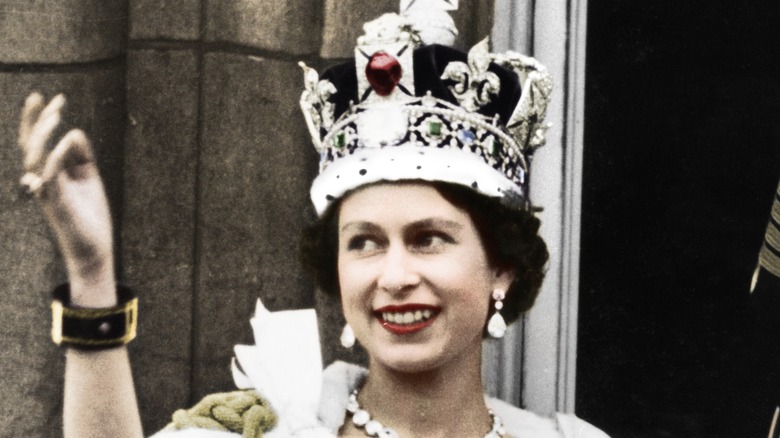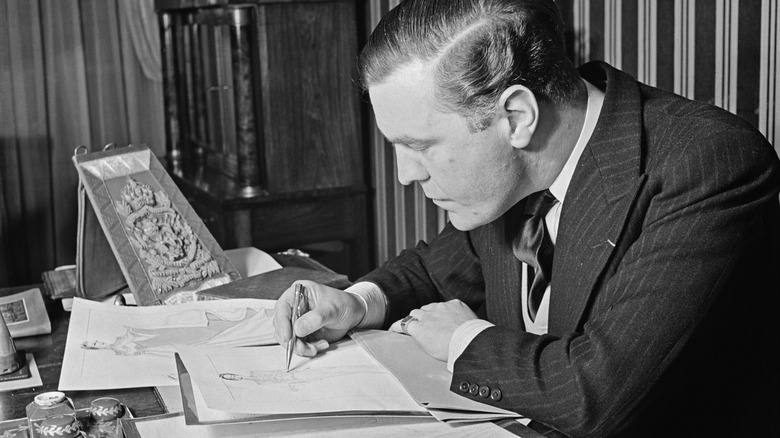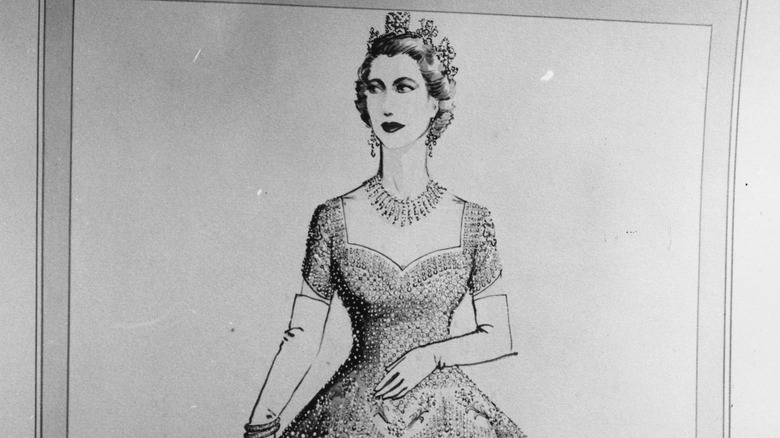The Secret Lucky Charm Hidden In Queen Elizabeth's 1953 Coronation Gown
In 2022, Britain will celebrate Queen Elizabeth II's Platinum Jubilee, marking 70 years since her coronation in 1953, based on reporting from The Telegraph. The queen is the first British monarch in history to reach this distinction, and to mark the occasion, a number of special events and celebrations are planned all throughout the year, according to the Royal family's website. None of what's planned, though, will likely match the lavish affair that was Queen Elizabeth's coronation in the 1950s, which was the first of its kind to be televised, as the Royal website also explains.
Elizabeth officially became Queen of England one year earlier, in 1952, but she was in Kenya. Thus her official coronation took place one year later. At that coronation, which was held at Westminster Abbey, she wore a dress specially designed by acclaimed English royal fashion designer Norman Hartnell (via Vogue UK). In an event that would be seen by millions, and to perhaps comfort the young royal, who was just 27 at that time, Hartnell hid a secret good luck charm in her gown. And Elizabeth was unaware.
Elizabeth's dress was made from satin
When it comes to a royal coronation, Hartnell spared no expense in his design for young Elizabeth. Her coronation gown — made from satin, just like her wedding dress, which Hartnell also designed — was threaded with gold and silver designs depicting national and Commonwealth emblems, such as the Canadian maple leaf and the lotus flower of India, per Express. On top of it all were opulent sequins, pearls, and crystals, according to People. It was on the left side of the skirt, though, where Hartnell made his most ingenious — and in some sense quite touching — addition to what Elizabeth Windsor would wear on such an historic occasion.
Naturally enough, Elizabeth had a hand in her dress design, which began eight months before the coronation took place, as art historian Jacky Klein told British TV's Channel 5 (via Express). According to Klein, the Welsh daffodil was replaced with a far less glamorous leek, per the young Royal's request. It was around this same time though, that Hartnell added a lucky charm on the gown, but he never told Elizabeth about it. It's where that good-luck charm was located on that fabric, though, that perhaps allowed Elizabeth to still enjoy the benefit.
Her hand rested on the symbol, although she didn't know it was there
The good luck charm that fashion designer Norman Hartnell had sewn into the dress that Elizabeth wore to her coronation was a four-leaf clover, positioned just so, on the left side of the skirt, where the queen would rest her left hand during the ceremony, even though she never knew it was there, as Klein continued on Britain's Channel 5 (via Express). It's not known when or how Elizabeth ever found out about Hartnell's gesture.
It is known that Queen Elizabeth uses good luck charms to this day, such as miniature horses and dogs she carried with her representing her children, as Express also notes. For this reason, Hartnell's inclusion of the shamrock would likely be meaningful and would be in keeping with Queen Elizabeth's character. Since her coronation, Elizabeth wore Hartnell's dress six more times, according to the official Royal website. It is now on view at the Royal Collection at Buckingham Palace.


